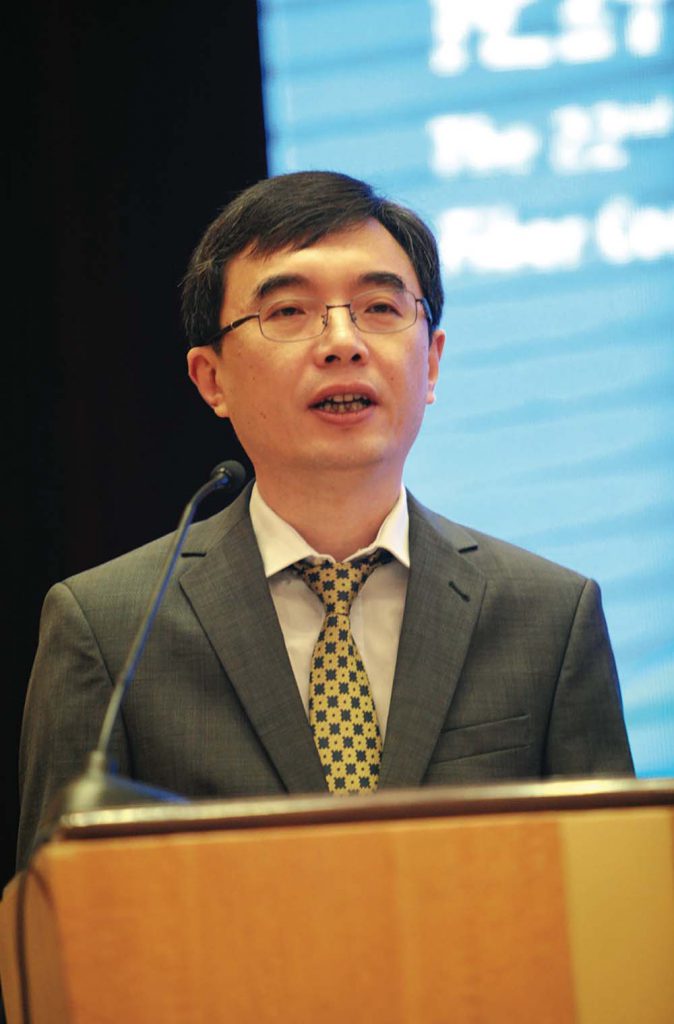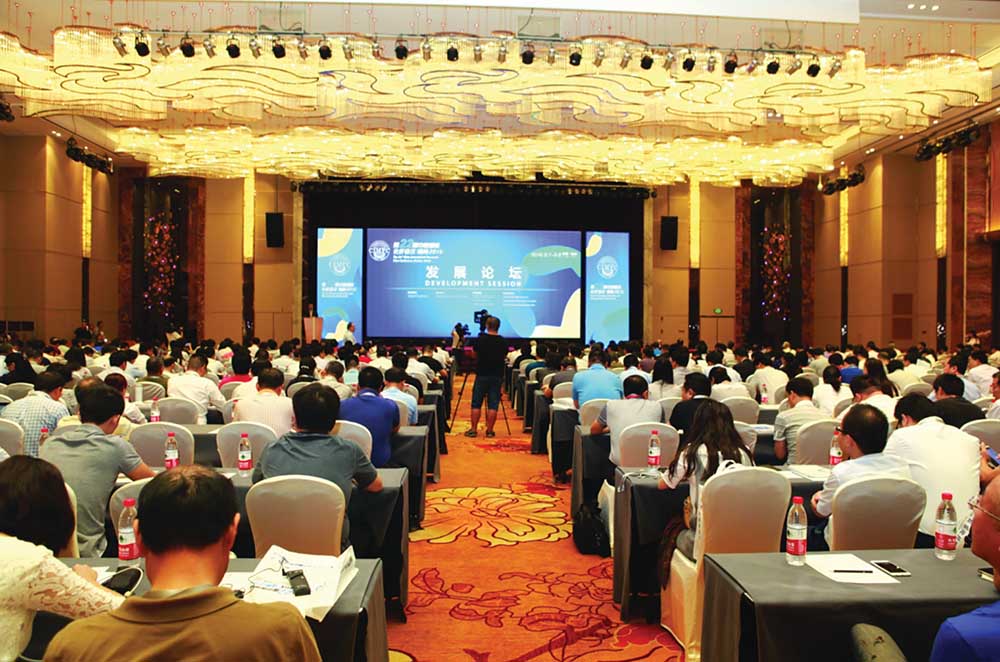Attendees at the 22nd China International Manmade Fiber Conference (CIMFC) held in Fuzhou in September.
At the 22nd China International Manmade Fiber Conference (CIMFC), held at the beginning of September in Fuzhou (Fujian province), China, experts and executives spoke about advanced materials, fashion trends, testing methods and standards, and investment trends within the industry. Experts said the Chinese and global fiber industry predicted a slower but steady growth in the next five or more years.
Chemical fibers in Fujian
This was the first time in a decade that the CIMFC was held outside Zhejiang and Jiangsu provinces. Fujian is China’s third largest manufacturing province for chemical fibers, after Zhejiang and Jiangsu. In 2015, Fujian produced a total of nearly 6 million metric tons of chemical fibers, which is about 12% of China’s total production of 48.3 million metric tons. Fujian’s production of chemical fibers is larger than any country’s outside China. In the same year, Zhejiang and Jiangsu took, respectively, 44% and 30% of China’s production. On the other hand, the other 28 provinces or province-level regions produced a total of only 14% of China’s chemical fibers in 2015.
Fujian was also the main driving force of the Chinese chemical fiber industry in 2015. Fujian’s production increased over 25% in 2015 from the previous year, much faster than Zhejiang’s 12%, Jiangsu’s 8%, and the whole country’s average of 10%.
Fast-growing production results are also increasing revenues. Currently, there are more than 500 mid- and large-size chemical fiber companies in Fuzhou, capital of Fujian Province. “These companies had a total production, in terms of values, of 207.3 billion yuan ($33.4 billion) in 2015, and grew by 11.2% from 2014. Chemical fiber has become the first industry in Fuzhou that has annual sales of over 200 billion yuan,” said Chen Ju, an official from the Fuzhou government.
Attendees and forums
About 600 fiber professionals from more than 20 countries or areas attended the 22nd CIMFC during the two-day conference in September 2016. And they were mostly from Mainland China. Other attendees were from the United States, France, the United Kingdom, Japan, Korea, Thailand, Taiwan, etc. More than 70 experts spoke at the ten forums of the conference.
The 22nd CIMFC was organized by the China Chemical Fibers Association (CCFA), and included ten sub-forums: the Development Session, which illustrate the main trends of the Chinese and global manmade fiber industry; the High Performance Fiber & Composite Materials Session; the Advanced Vinylin Technology Session; the Oversea Investment of France Textile in a Nutshell Session; the Nylon Development in Transformation Session; the Development of Acrylic Fiber Industry Session; the Testing and Standards Session; the Development Forum of Viscose Industry Session; the Brand Matchmaking of China Fibers Fashion Trends Session; and the Advanced Fiber Technology Session.
China Market
Duan Xiaoping, president of CCFA, said at the conference that China’s output of chemical fibers accounted for 70% of the global production in 2015. The China National Textile and Apparel Council (CNTAC) and CCFA together presented China’s forecasts for the textile and chemical fiber industries for the 13th Five Year Period (2016-2020) in a report released at the conference. According to the report, China’s output of chemical fibers will reach 57 million metric tons by 2020, growing at a compound annual growth rate (CAGR) of 3.3% from the 48 million metric tons in 2015.

The reports also said that high-performance fibers and composite materials, differentiated and multi-functional fibers, and bio-based fibers such as bio-based poly trimethylene terephthalate (PPT), poly (3-hydroxybutyrate-co-3-hydroxyvalerate) (PHBV), and polylactic acid (PLA) will be the three main focus areas of the Chinese chemical fiber industry in the next five years.
This report also forecasts the three major segments in the Chinese chemical fiber industry for the next five years. The three major segments include industrial fibers, home-textile fibers and garment fibers. The trends are:
- Industrial fibers will be the main driving force of the Chinese manmade fiber market, growing at a CAGR of 9.1% from 12.1 million metric tons in 2015 to 18.8 million metric tons by 2020. The share of industrial fibers in the Chinese manmade fiber market will increase from 25.3% to 33% in the same period.
- Home-textile fibers will have a moderate growth of a CAGR of 2.7% from 13.5 million metric tons in 2015 to 15.4 million metric tons in 2020. However, their market share will decline from 28.1% to 27%.
- Garment fibers will suffer stagnation in the next five years. This segment will grow at a CAGR of 0.4% from 22.4 million metric tons in 2015 to 22.8 million metric tons by 2020. Though still being the largest among the three major segments, the garment fibers’ market share will decline from 46.6% to 40%.
Global Market
Manmade fiber production in most other countries suffered from a downturn over the last few years. But experts expect stable or increased profits from industrial fibers or high-performance fibers for the coming years.
In Europe, production of chemical fibers remained at 3.4 million metric tons, said Frederic Van Houte of the European Man-Made Fibres Association (CIRFS). He said that Western Europe (WE) kept stable, while Central and Eastern Europe (CEEC) had increased production in 2015; and the production of garment-based chemical fibers declined, while industrial fibers such as automotive fibers kept stable in 2015. He expected the production of garment chemical fibers and home-textile chemical fibers would recover in 2016. He also said the global production of chemical fibers reached 68.9 million metric tons by 2015, with production led by China, India, the European Union, the United States, Taiwan, Indonesia, South Korea, Thailand, and Japan.
While China aims to increase its competitiveness for high-performance fibers, Japan has established its leading position in this sector. The Japan Chemical Fibers Association (JCFA) presented the current situation of the Japanese industry at the 22nd CIMFC. Though Japan had only 960,000 metric tons of chemical fibers produced in 2015, a 2% decline from the previous year, the country still dominates the markets of several important high-performance fibers, including PAN-based carbon fiber (68% of the global market), para-aramid fiber (47%), polyarylate fiber (100%), and high molecular weight polyethylene fiber.
In South Korea, chemical fiber output had been gradually declining from 2.63 million metric tons in 2000 to 1.34 million metric tons in 2015. In the same period, the country’s export of chemical fibers to China dropped from 0.62 million to 0.305 million metric tons, while import from China was up from 0.08 million to 0.443 million metric tons. The Korea Chemical Fibers Associations (KCFA) said in the conference that functional fibers are the future of the Korean chemical fiber industry.
As China contributes more than 70% of the global chemical fiber production, the global market will grow at a rate very close to China’s 3.3% per year. If the rest of the world outside China can maintain a growth of over 3% per year, as some experts predict, the global chemical fiber output will grow at an average of 3.2% per year from 2015 and 2020, which will still provide many opportunities to the industry worldwide.


